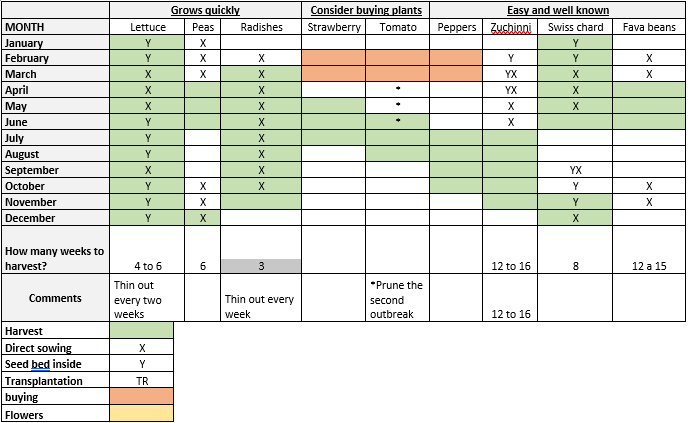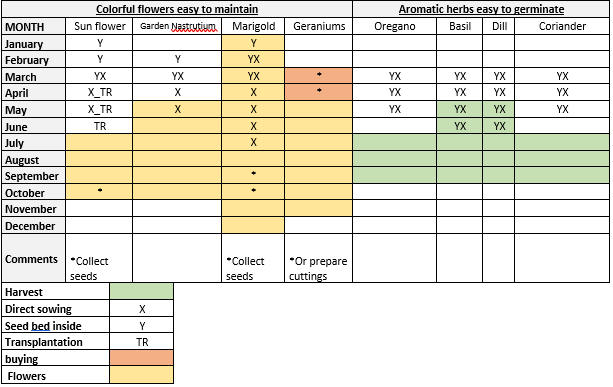After the visitors, plants are the second most important element in the therapeutic garden. It is a good idea to take time and carefully chose plants for the garden. The rule of 40 /60 percent hard surface / soft surfaces (planting) is usually a challenge, but even if it not possible to have a percentage of 60 percentage of plants on the garden surface there are ways of creating a feeling of exuberant green atmosphere in the garden. One recommendation, in addition to the following text, is to introduce plants on all levels: groundcover, creepers, climbers, and shrubs, small and middle sized trees. (English garden style).

Image 37. Ulla Molins garden, Höganäs, Sweden. Mixture of groundcover, shrubs, climbers and trees. Picture pinterest
The actual plants, shrubs and trees used in the therapeutic garden will vary with the location of the garden and tastes and culture of the users. Still, choosing plants will consider different purposes in the design such as:
- Trees for shade
- Planting for activities, for example vegetables, fruit and herbs to be grown and harvested, bulbs and annuals can be plants to be picked and arranged etc.
- Trees and shrubs as landmarks to provide good orientation
- Plants with year-round interest so there is always something to enjoy.
- Plants for sensory stimulation
- Plants that attract wildlife and birdlife
- Plants that trigger memories (specially in care homes)
In the following chapter there will be suggestions of plants for different purposes, most of them for use in central Spain, but many of them can be used all over Europe. A recommendation is to check out the requirements for each plant and see if it is possible to use in the geographical location, and if it is not possible, try to find a similar plant adapted to the geographical area.
Attached to this text you will find annex with suggestions of plants from Mediterranean therapeutic gardens and a Scandinavian therapeutic garden.
As for all parks and garden designs, it is important to choose plants thinking of their maintenance and keeping environmental awareness in mind. Some considerations are: choosing plants with low water consumption, plants adapted to the area, and use resistant varieties, (not use unnecessary chemical pesticides). Sometimes it could be justifiable to use a variety in a therapeutic garden even though it does not pass the environmental exam. One example is the use of lawn in the Mediterranean countries to encourage people to walk on it without shoes or just sit and smell the freshly mown grass.
Last, but not least, there are plants that are NOT suitable for a therapeutic garden. The following type of plants are better to avoid*:
- Toxic plants
- Plants with thorns (exceptions are roses…)
- Common allergy inducing species (grass pollen, birch, cedar…)
- Very fast-growing invading plants (Mentha, ivy, cortadería and other gramineas…)
- Plants that cause problems to keep garden clean (trees with fruits and continues falling leaves/needles)
- Plants that are sensitive to pests and diseases
*Please consider security for each user and visitor of the garden.
Trees for shade
Most countries have a season when it might be necessary to find protection from the sun. One of the most natural and comfortable shade is from a tree, as it provides soft moving shade in the form of a canopy. Trees for shade are very often used along paths and to shade small sitting areas. There are some properties that should be considered when choosing the tree shade in the therapeutic garden:
- Use varieties that do not have a heavy leaf fall or fruits that can fall on the paving and cause slippery surfaces.
- Use varieties where the roots do not grow horizontally to search for water causing roots on the ground level or even lifting pavements
- Use small or middle-sized trees, except where there is a park sized outdoor space. The small sized trees could be used in planters and in that way given extra length and altitude to create a bigger shade. (Bigger trees that one can prune is also a good alternative)
Examples of perennial trees for shade:
Pinus mugo Mops (uncinate) / Pinus mugo Pumilio/ Picea omorika/ Cupressus/ Arbutus Unedo, Ligustrum japonicum, Magnolia, Citrous (lemon and orange)/Laurus nobilis
Examples of deciduous trees for shade:
Catalpa bigonoides, Tilo, Prunus cerasifera ‘Nigra’, Robinia pseudoacacia ‘Umbraculifera’, Morus alba fruitless, Albizia julibrissin, Cercidiphyllum japonicum, sorbus comixta /sorbus/ Amelanchier arborea ‘Robin Hill’./
Smaller varieties to be used when very small space or in a pot:
Acer japonés, Sumatra, Pterocarya rhoifolia, Pyrus salicifolia, Salix caprea ‘Kilmarnock’, Salix integra ‘Hakuro-nishiki’, Malus Everest
Plants for Activities and year-round interests
A therapeutic garden should present surprises to be discovered during the whole year. Most of these plants could be associated with some kind of therapeutic activity.
The most common activities to strengthen the relation between person and plant are the horticulture gardening activities. The selection of horticultural production is not emphasized in the design; instead, its significance lies more in the methodology and therefore treated very briefly in this chapter. In the next image you will find some examples of how to think when choosing plants for a year-round interest and with a connection to an activity/culture/tradition.
The most important thing to keep in mind is biodiversity, the more species present in the garden, the more activities and therapies choices.

Image 38. Choosing plants for a year-round interest in the therapeutic garden. Poster by Jardines Terapéuticos Palmlöf)
Plants for sensory stimulation
Sensory stimulation needs to be addressed on a daily basis and year-round to support all five sensory realms. This work can help to compensate for sensory changes and losses, to maintain function and to provide a high level of engagement in the therapies. As seen in the chapter about modules, not only plants provide this sensory stimulation but the garden room as it is designed to be able to: observe wildlife, night sky, having a footbath, feeling cool change in the air, sounds from water and air, smelling humidity etc.
Almost all plants in the therapeutic garden provide some kind of sensory stimulation. The most popular are the use of aromatic plants and herbs (salvia, oregano, sage, rosemary…). Many of the aromatic plants are small and it is a good idea to plant them in raised beds.
Perennial flowers and plants not only give sensory stimulation but are also decorative and attract wildlife to the garden. It is usually easy to grow a combination of perennials that could give plenty of activities in the therapeutic garden. Many aromatic herbs belong to perennial plants and the taller ones can be easily mixed with flowers in the same flower bed.

Image 39. Flower bed with a mixture of aromatic herbs and perennial flower. This flower bed gives plenty of sensory stimulation and elements for therapy.
To choose sensory stimulation plants for the whole garden area, the following hints could be good to keep in mind:
Sound – To stimulate hearing, choose flora that makes noise when the wind passes through them, such as bamboo stems. Many seedpods make interesting sounds as well and the end of season leaves provide a fun, crunching sound under feet.
Touch – There is no shortage of plants that offer interesting textures, perfect for encouraging the sense of touch. From the baby-soft feel of a lamb’s ear to the irresistible sensation of cool moss through the fingers or the brush of rough seedpods, it is possible to incorporate many different textures into the garden.
Smell – The sense of smell is extremely memorable and aromas easily find their place in our memory banks. Most sensory gardens are full of mingling aromas that entice a wide range of emotions. Highly aromatic plants, such as the sweet smelling gardenia, honeysuckle, herbs, and spices, provide ample opportunity for stimulation.
Sight – Adding visual interest to a sensory garden can be achieved by using plants with varying habits such as those that creep, climb, trail, bush, or stand upright. Incorporating plants with different bloom, leaf, bark, and stem colors provide visual appeal as well. Remember to add plenty of flowers with different blooming times. In this way the garden will always have a colored feature.
Taste – Edible fruits, herbs, and spices planted in a sensory garden allow visitors an opportunity to experience nature’s bounty while enticing their taste buds. Vegetables can also arouse the taste buds.
It could be a good idea to gather interesting sensory plants at one place in the garden, where the professionals know they can find plants for their session in sensory stimulation. To lead visitors to explore on their own it is a good help to put up signs. Next there is a list of recommendations of sensory plants that will fit into pots and raised beds. The list indicates if the plant is present all year round or only summer /spring season.

Image 40. Plants for sensorial stimulation gathered in raised planters. Jardín Terapéutico Residencia Nª Sº Perpetua Socorrro, Madrid (foto Jardines Terapéuticos Palmlöf)


- P= Spring
- V= Summer
- O= Fall
- ∞= All year round
Literature to help choose plants:
- https://www.flowerpotman.com/sensory-gardens-at-home/sensory-garden-plants/
- Horatio’s Garden Plant List (Annex)
- Gestlatningsprogram för utemiljön vid V`rd och Omsorg, Hjälpmedelsinstitutet (Annex)
- Jardines Terapéuticos, Madrid (Annex)
Plants that trigger memories
Plants, especially flowers, are great for triggering memories. This can be especially rewarding for older care home residents, where popular favorites can bring a sense of the domestic garden. Familiar plants can have powerful associations for people living with dementia and memory loss. If possible, involve people in collecting memories and stories so you know what plants you need, for example by making collages of pictures of flowers and plants.
In a garden it can be as simple as including some containers of annual flowers that are old favorites e.g. marigolds, forget-me-nots, pansies and snapdragons. Try letting the grass grow longer between cuts so the daisies can flower and have a tub or two for planting favorite vegetables e.g. potatoes, runner beans or growing some fresh mint for making tea.
Designs can also include features intended to bring back memories. For example, an old garden shed with tools, a border of old-fashioned scented roses or old clay pots.
Huerto de horticultura
La mejor elección de verduras, bayas y frutas en un jardín terapéutico suelen ser los cultivos hortícolas habituales de la zona geográfica. Deben ser fáciles de cultivar y mantener. En muchos países europeos la horticultura se ha popularizado y hay mucha información en Internet:
https://www.thrive.org.uk/get-gardening?tags%5B%5D=255354
The main objective of a therapeutic horticulture garden is not production but to improve or maintain the capacities of the users.
Here an example of an easy year round horticulture crop (graphics by Jardines Terapéuticos Palmlöf):



[1] Please consider the safety of each garden user and visitor.